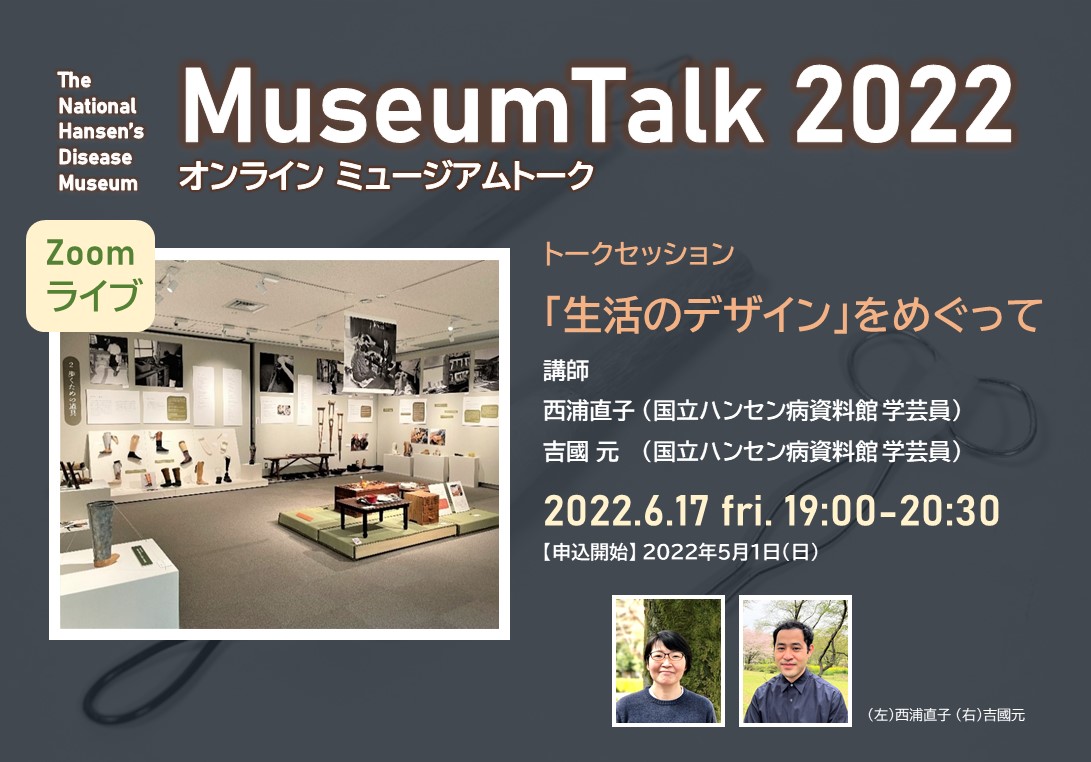Event details
- Top
- event information
- Event List
- [Holding Report] Museum Talk 2022 / Special Exhibition "Design of Life" Related Project <Talk Session "Design of Life"> (3rd Online Held)
2022.06.17
Museum Talk 2022 / Special Exhibition "Design of Life" Related Projects
<Talk session on “Lifestyle Design”> (3rd online event)
*The event has ended.

Special exhibition "Design of life" related projects<Talk session "Design of life">
Lecturers: Naoko Nishiura (Curator The National Hansen's Disease Museum) / Gen Yoshikuni (Curator The National Hansen's Disease Museum)
The National Hansen's Disease Museum The "Online Museum Talk" seminar series will be held again this year. The third session will be related to the current exhibition "Self-help Devices, Artificial Limbs, Prosthetics, and Orthotics and Their Users in the Design of Life Leprosy sanatorium" (March 12 (Sat.) to August 31 (Wed.), 2022) at The National Hansen's Disease Museum, and will be the first night museum-style exhibition presentation at The National Hansen's Disease Museum. The two curators in charge of the exhibition will talk about various episodes that left an impression on them in the process of creating the exhibition. We hope you will join us.
Outline of the event
Friday, June 17, 2022, 7:00pm to 8:30pm via Zoom
Advance registration required: 100 people capacity (first come, first served)
Application period: May 1, 2022 (Sunday) 9:00AM to June 16, 2022 (Thursday) 5:00PM (Applications will close once capacity is reached)
Reception starts at 6:45pm
X (formerly Twitter) Facebook
Related projects for the special exhibition "Design for Life"
<Talk Session: "Designing Lifestyles"> Event Report
Lecturer Naoko Nishiura, Gen Yoshikuni (Curator, The National Hansen's Disease Museum)
The National Hansen's Disease Museum 's first night museum talk session, "About the Design of Life," was fully booked and could be held. The event explained the origins and overview of the special exhibition "Design of Life," and then, through a pre-recorded video, explained the relationship between Patient procedures in sanatoriums and their disabilities, the relationship between tools, "Tools for Walking" which includes prosthetic limbs, prosthetic shoes, and other prosthetic devices, and "Tools for Hands" which introduces tweezers, button fasteners, and spoons and forks with self-help devices.
After the talk session, the second half of the event was also presented as a video, and it explained "each person's tools" that allow them to enjoy entertainment and express their individuality, as well as three other topics.
In the first half of the two-part talk session, Mr. Ikeda spoke about the key points of the exhibition's expression, asked how sensory paralysis can be understood, and described how serious the conflict between daily life and medical care is for Former leprosy patients.
The second half of the discussion focused on medical-led "paternalism" and the significance of tools and literature as a silent form of resistance to it, as well as on the challenges of how to present people through materials in an effort to improve exhibitions, given the decreasing opportunities to hear the stories of Former leprosy patients.
We have also prepared an archived version of the commentary and talk session, which includes a Q&A session and after-talk. It will be posted on The National Hansen's Disease Museum 's YouTube channel, so please take a look.
From the questionnaire
- Weaving the life of residents from things. I thought it was a wonderful attempt.
- From various ideas to protect the body from injury, I felt something like a strong will beyond what was needed. Tanka, literature, artificial legs, self-help tools, etc. have a feeling that each person lived and "want to live like this", and we want to imagine and think about it.
- It was a very fruitful time for me to understand the part and the whole of the exhibition by listening to the points that the two of us were particular about when working on the exhibition. Thank you very much.
- He explained the picture of taking a bath with a bandage due to a wound on the sole of the foot and a tanka saying "I'm proud to take a bath from my feet". I wondered if there was any pain, and the joy of gaining "small freedom" in it was more clearly conveyed here.
- It was the first night to be held, and I enjoyed the method that was unfolded by the talk of the curator who was involved. Not only "explanation" and "explanation", but also the contents that can be seen through the exchanges gave us a glimpse of the difficulties and ingenuity when exhibiting. I think that it was through these projects that I learned how assistive devices and orthotic devices support the lives of residents, and how the world expands and leads to joy.
- I watched it from overseas. Thank you for this opportunity when it is difficult to return to Japan. I am also a prosthetist. I was able to see valuable prostheses and orthotics, and thought about various things. It is natural that we, prosthetics and orthotists, must always grasp the situation and feelings of patients and users, reflect them in things, and make them, but it was an opportunity to reconsider the origin. ..
- In today's commentary, we must not forget that we are an extension of the history of being deprived of human rights and winning our own human rights, and that we are "I" in various ways. I felt the sincerity of things again.
… We have received many other answers. Thank you very much.
State of holding




<Inquiries>
国立ハンセン病資料館 ミュージアムトーク担当 mt@nhdm.jp
